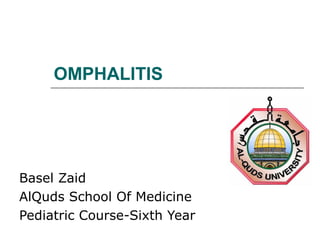
Omphalitis 2
- 1. OMPHALITIS Basel Zaid AlQuds School Of Medicine Pediatric Course-Sixth Year
- 2. Omphalitis “Case Hx” Pt ID : Mohammad .Y from Ramallah 7 days male Product of NVSD, full term, BWt 3.66 Kg. Fever since yesterday (38.5-39.5) C Umbilical yellowish discharge surrounded by erythema since yesterday. Hypoactivity in the past 2 days. (-) Vomiting, Diarrhea, Skin rash, Abnormal movements, Cyanosis, Cough or runny nose. Maternal UTI in the last week of pregnancy. Exclusively Breast fed Immun: 1st Dose Hep B + BCG
- 3. Omphalitis (Case PE) Generally: Alert, mildly jaundice, NOT| in respiratory distress. No Signs of dehydration HR 126 RR 39 Temp 38.8 C Wt 3.67 Ht 52 HC 37 ENT : NL,, NO LAD No dysmorphic features Chest & Heart examination were NL ABD: soft, lax, NO Organomegaly.NL Genetalia. Extremity: No deformity, No Oedema Neuro Ex : NL, Normal Reflexes.
- 4. Omphalitis (Case Follow Up) Working Diagnosis : 1- Omphalitis 2-Sepsis 3-LAD CBC,ESR,CRP urine analysis+ urine culture blood culture--- CSF analysis and Culture Umbilical swab culture RBS BUN, Cr, TSB ,,serum electrolytes. Take weight daily Observe v/s “HR,Temp” and BP Observe O2 sat to be more than 92% all the time. Feeding as tolerated
- 5. Omphalitis (Case Follow Up) Start on ATB : Oxacillin IV Q 6 hours+ Claforan IV Q 6 hours+ Fucidine cream topically White blood cells 20 Erythrocyte Sedimentation Rate 40 Neutrophils granuloc% 58% C- Reactive Protein - CRP ++ Lymphocytes% 25% AST (GOT) 12 Red blood cells (RBC) --- ALT (GPT) 23 Haemoglobin (HGB) 17.9 Creatinine, serum 0.2 hematocrit (HCT) --- Urea 22 Mean cell volume (MCV) 101 Random blood sugar (RBS) 96 Mean cell haemoglobin (MCH) ----- Uric Acid --- Mean cell haemoglobin concentration (MCHC) --- Bilirubin, Total 8 Red blood cell distribution width ---- Alkaline phosphatase 295 Platelets 385 CSF Analysis “total cells” 25 Na 132 CSF WBC 20 K 4.7 CSF sugar 49
- 6. Introduction Omphalitis is an infection of the umbilical stump. It typically present as a superficial cellulitis i.e. as a red ‘flare’ in the periumbilical skin. The cellulitis may progress rapidly with potentially serious consequences including systemic disease e.t.c. Omphalitis is predominantly a disease of the Neonates.
- 7. Epidemiology / Aetiology Internationally, overall incidence is < 1% Approximately 85% OF Cases are polymicrobial in origin. Aerobic bacteria present in 85% of infections predominated by Staphylococcus aureus, Group A Streptococcus, Escherichia coli, Klebsiella pneumoniae. Pseudomonas species have been implicated in particularly rapid or invasive disease.
- 8. LAD (Leukocyte adhesion deficiency) • Omphalitis occasionally manifests from an underlying Immunologic disorder. • These infants are subsequently diagnosed with Leukocyte adhesion deficiency, a rare disorder with AR pattern of inheritance. These infants present with the following; • 1-Leukocytosis • 2- Delayed seperation of the umbilical cord • 3-recurrent infections.
- 9. Clinical Features In term infant the, mean age at onset is 5-9 days. Patient present with redness and swelling (cellulitis) around the umbilicus. Purulent or mal odorous discharge from the umbilicus. Baby is highly irritable. The cellulitis is rapidly progressive and may lead to necrotizing fasciitis. Necrotizing fasciitis is characterized by abdominal distension, fever and tachycardia. Despite the illness, most of the neonates at presentation have good appetite and continue to suck.
- 10. Management History- detailed history of the pregnancy, labour, delivery and neonatal course. Physical Examination Physical signs vary with the extent of the disease. Local disease; signs of localized infection include the fllg Purulent or mal odorous discharge from the umbilical stump Periumbilical erythema Edema Tenderness Extensive local disease; such as fasciitis or myonecrosis. These signs may suggest infection by both aerobic or anaerobic organisms. Periumbilical ecchymosis Crepitus Bullae Progression of cellulitis despite antimicrobial therapy
- 11. Baby O.T.with extensive local disease & systemic disease
- 12. Lab studies Obtain specimen from umbilical infection for Gram stain & culture for aerobic and anaerobic organisms. Blood culture for aerobic and anaerobic organisms. CBC RBS –hypoglycaemia Other non specific lab tests. None has demonstrated sensitivity or specificity sufficiently high to dictate clinical care. These are; C-reactive protein level Erythrocyte Sedimentation rate Limulus lysate test, which detect endotoxin
- 13. Treatment Treatment Medical Care Surgical Care Antimicrobial Supportive Steroids ? Therapy Care ?
- 14. Antimicrobial therapy Parenteral antimicrobial coverage for gram - positive and gram – negative organisms. A combination of anti – Staphylococcal penicillin and an Aminoglycoside is recommended. Anaerobic coverage is important in all patients. As with anti microbial therapy, local antibiotic sensitivity patterns is considered. CLOXACILLIN + GENTAMICIN + FLAGYL OR CEPHALOSPORIN + GENTAMICIN +FLAGYL forms the usual antimicrobial combination.
- 15. Surgical care Early surgery may be life saving. It involves early and complete surgical debridement of the affected tissues and muscle. Excision of pre peritoneal tissue ( umbilicus, umbilical vessels) is critically important in the eradication of infection. These tissues can harbour invasive bacteria and provide a route for progressive spread of infection.
- 16. Prognosis The prognosis for most infants is variable. • In most cases prognosis is Poor. • Omphalitis with complications is associated with mortality rate up to 80% in developed countries. • In the less developed countries, mortality is > 95%
- 17. Differential diagnosis Anterior abdominal wall cellulitis Neonatal septicaemia Burns Urachal cyst with 2º bacterial infection.
- 18. THE END THANK YOU .
Notas del editor
- Urachus : ibrous remnant of the allantois, a canal that drains the urinary bladder of the fetus that joins and runs within the umbilical cord
